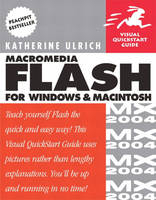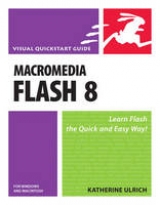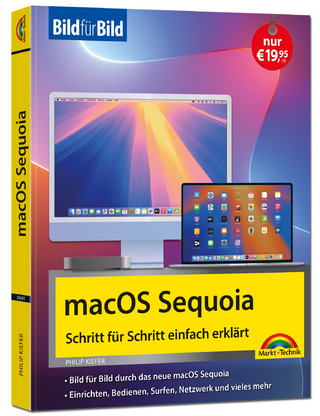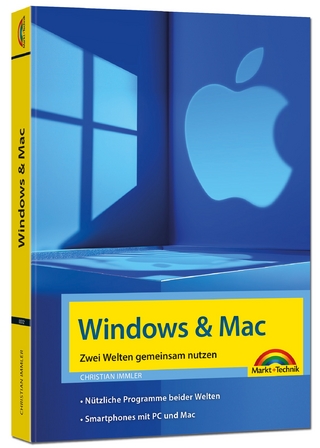
Macromedia Flash MX 2004 for Windows and Macintosh
Peachpit Press Publications (Verlag)
978-0-321-21344-0 (ISBN)
- Titel erscheint in neuer Auflage
- Artikel merken
New timeline effects and behaviors, better run-time performance (which equals faster graphics display and video playback), native support for PDF and EPS forms, a slew of workflow enhancements, an improved programming language, a redesigned interface--these are just a few in the long list of new features that have Web designers salivating over the newest version of their favorite Web tool: Macromedia Flash MX 2004. Whether you're brand new to the world of Flash development or a veteran chomping at the bit to take advantage of all the latest features, this task-based guide will have you creating high-impact, interactive Web sites with Flash MX 2004 in no time. Best-selling author Katherine Ulrich is at it again here, using simple step-by-step instructions and loads of visual aids to cover every aspect of Flash design, from the basics of vector animation to sophisticated interaction and transition effects. Throughout, you'll find the direct, friendly language and plethora of tips that have become the hallmark of the popular Visual QuickStart series.
Katherine Ulrich is a writer and editor specializing in graphics, publishing, and multimedia software. Her career includes a 12-year stint at Macworld magazine. Katherine wrote the previous best-selling editions of Flash: Visual QuickStart Guide.
Introduction.
1. The Flash Authoring Tool.
Understanding Flash Basics. Working with Flash Documents. Working with Template Documents. Touring the Flash Authoring Environment. About the Timeline. About Document Properties. Using Grids. Using Rulers and Guides. Working with Snapping. About the Toolbar. Viewing Graphics at Various Magnifications. About Panels. Working with Grouped Panels. Using Customer Panel Sets. About the Property Inspector. Using the Help Panel. Customizing Keyboard Shortcuts.
2. Creating Simple Graphics.
Touring the Tools. Using the Line Tool. Setting Stroke Attributes. Setting Fill Attributes. Using the Geometric Shape Tools. Using the Pencil Tool. Using the Pen Tool: Straight Lines. Using the Pen Tool: Curved Segments. Using the Paint Bucket. Using the Brush Tool in Normal Mode. Using the Text Tool. Working with Vertical Text. Setting Text Attributes. Setting Paragraph Attributes. Breaking Apart Text.
3. Modifying Simple Graphics.
Setting Selection Preferences. Selecting Lines with the Selection Tool. Selecting Fills with the Selection Tool. Using a Selection Rectangle. Using the Lasso Tool. Deselecting Elements. Repositioning Elements Manually. Repositioning Elements Numerically. Basic EditingTasks: Cut, Copy, Paste. Editing Existing Elements with Assistance. Moving End Points with the Selection Tool. Moving Points with the Subselection Tool. Reshaping Curves with the Selection Tool. Reshaping Curves with the Subselection Tool. Converting, Removing, and Adding Points. Reshaping Fills. Changing the Size of Graphic Elements. Reorienting Graphic Elements. Distorting Graphic Elements. Changing the Envelope of Selected Elements. Modifying Strokes. Using the Eraser Tool in Normal Mode. Using the Faucet Modifier. Modifying Fill Colors. Creating Solid Colors: Color Mixer Panel. Creating New Gradients. Creating Color Sets. Putting Gradients to Work. Modifying Applied Gradients. Applying Attributes of One Graphic Element to Another. Converting Lines to Fills.
4. Complex Graphics on a Single Layer.
Understanding Grouping. Working with Grouped Elements. Controlling the Stacking Order. Editing Groups. Aligning Elements. Using the Complex Paint Modes with the Brush. Using the Eraser Tool with Multiple Shapes. Applying Gradients to Multipart Shapes.
5. Graphics on Multiple Layers.
Touring the Timeline's Layer Features. Creating and Deleting Layers and Folders. Controlling Layers and Folders. Setting Layer Properties via the Timeline. Controlling Layer Visibility in the Timeline. Controlling the Stacking Order of Layers. Organizing Layers in Folders. Working with Graphics on Different Layers. Cutting and Pasting between Layers. Distributing Graphic Elements to Layers. Working with Guide Layers. Working Mask Layers.
6. Saving and Reusing Graphic Elements.
Understanding the Library Window. Understanding Library-Window Views. Understanding Library Hierarchy. Converting Graphics to Symbols. Creating New Symbols from Scratch. Using Symbol Instances. Modifying Symbol Instances. Creating Static Symbols via Timeline Effects. Swapping One Symbol Instance for Another. Editing Master Symbols. Modifying Timeline Effects. Duplicating Master Symbols. Deleting Master Symbols. Converting Symbol Instances to Graphics. Copying Symbols between Movies. Creating Shared Libraries. Using Font Symbols.
7. Frame-by-Frame Animations.
Using the Timeline. Creating Keyframes. Creating In-Between Frames. Selecting Frames. Manipulating Frames in One Layer. Removing Frames. Making a Simple Frame-by-Frame Animation. Previewing the Action. Smoothing the Animation by Adding Keyframes. Using Onion Skinning. Editing Multiple Frames. Understanding Frame Rate. Varying the Speed of Animations.
8. Animation with Motion Tweening.
Creating a Bouncing Ball with Motion Tweening. Adding Keyframes to Motion Tweens. Animating Color Effects. Animating Graphics That Change Size. Rotating and Spinning Graphics. Moving Graphics in Straight Lines. Moving Graphics Along a Path. Orienting Graphics to a Motion Path. Changing Tween Speed. Getting Help with Motion Tweens.
9. Animation with Shape Tweening.
Creating a Bouncing Ball with Shape Tweening. Morphing Simple Lines and Fills. Shape-Tweening Multiple Shapes. Transforming a Simple Shape into a Complex Shape. Creating Shapes That Move as They Change.
10. More-Complex Animation Tasks.
Understanding Scenes. Manipulating Frames in Multiple Layers. Animating Multiple Motion Tweens. Animating Shape Tweens in Multiple-Shape Graphics. Reversing Frames. Combining Tweening with Frame-by-Frame Techniques. Saving Animations as Graphic Symbols. Using Animated Graphic Symbols. Creating Animated Graphic Symbols with Timeline Effects. Saving Animations as Movie-Clip Symbols. Using Movie-Clip Symbols. Using Animated Masks.
11. Building Buttons for Interactivity.
Creating a Basic Button Symbol. Creating Shape-Changing Button Symbols. Creating Fully Animated Button Symbols. Creating Invisible Button Symbols. Creating Button Symbols with Multiple Hot Spots. Using Buttons Components. Modifying Button Components. Creating Movie-Clip Buttons.
12. Basic Interactivity Using Behaviors.
Touring the Actions Panel. Customizing the Actions Panel. Organizing Frame Actions. Adding Frame Actions. Adding Event Handlers via Behaviors. Previewing Actions at Work. Changing Event Handlers via Behaviors. Working with Multiple Behaviors. Using Multiple Handlers for One Button. Modifying a Behavior's Action. Triggering Actions from the Keyboard. Adding Actions to Movie-Clips. Adding Actions to Movie-Clip Buttons. Making Movie-Clip Buttons Display Additional States. Using Buttons to Control Movie Clips. Using the Script Navigator.
13. Authoring Utilities.
Setting Movie Explorer Parameters. Searching and Editing with Movie Explorer. Choosing Spelling Checker Options. Working with Personal Dictionaries. Running the Spelling Check. Using Find and Replace. Carrying Out a Find-and-Replace Operation. Using the History Panel. Undoing/Redoing Steps via the History Panel. Replaying Steps via the History Panel. Recording Steps with the History Panel.
14. Using Non-Flash Graphics.
Importing Non-Flash Graphics. Turning Bitmaps into Vector Graphics. Editing Bitmaps with Flash's Tools. Using Bitmaps as Fills. Modifying Bitmap Fills.
15. Adding Sound
Using Sounds in Flash. Importing Sounds. Organizing Sounds. Adding Sounds to Frames. Adding Sounds to Buttons. Using Event Sounds. Using Start Sounds. Using Stream Sounds. Stopping Sounds. Using Behaviors to Control Sounds. Repeating Sounds. Editing Sounds.
16. Adding Videos.
Importing Video. Using Embedded Video Clips in Your Movie. Updating Video Clips. Using Behaviors to Control Video Clips.
17. Delivering Movies to Your Audience.
Preparing Your Movie for Optimal Playback. Publishing and Exporting. Working with Flash Player Settings. Publishing HTML for Flash Player Files. Controlling Movie Placement in the Browser. Using Alternate Image Formats. Using Version Detection. Creating Projectors. Creating Publishing Profiles. Exporting Flash to Other Formats. Printing from Flash. Printing from Flash Payer.
Index.
| Erscheint lt. Verlag | 4.12.2003 |
|---|---|
| Verlagsort | Berkeley |
| Sprache | englisch |
| Maße | 229 x 179 mm |
| Gewicht | 1057 g |
| Themenwelt | Informatik ► Betriebssysteme / Server ► Macintosh / Mac OS X |
| Mathematik / Informatik ► Informatik ► Grafik / Design | |
| Mathematik / Informatik ► Informatik ► Web / Internet | |
| ISBN-10 | 0-321-21344-0 / 0321213440 |
| ISBN-13 | 978-0-321-21344-0 / 9780321213440 |
| Zustand | Neuware |
| Informationen gemäß Produktsicherheitsverordnung (GPSR) | |
| Haben Sie eine Frage zum Produkt? |
aus dem Bereich



